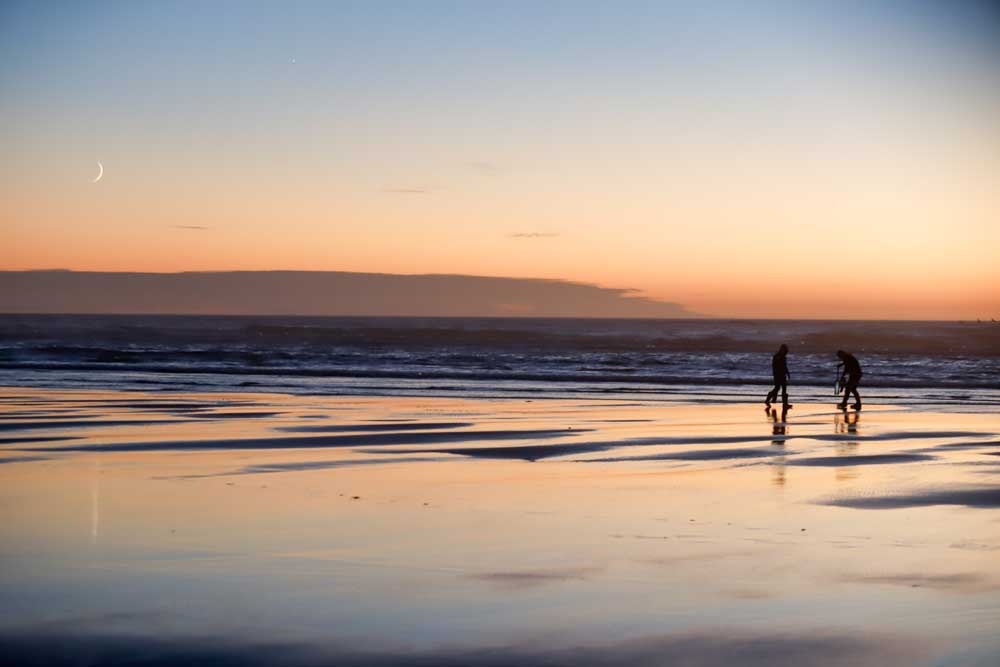Clamming under a crescent moon: Nearly 5,000 clammers ‘dig’ first fall series
Published 8:44 pm Sunday, October 6, 2024

- “Clear skies and a crescent moon allowed for diggers to enjoy a beautiful sky full of stars the past couple nights. I think the rain Friday resulted in lower turnout, even though it was dry and calm by the time low tide occurred in the evening,” said WDFW coastal shellfish biologist Bryce Blumenthal.
LONG BEACH PENINSULA — Calm seas, clear skies and abundant clams.
The first round of fall recreational razor clam digs for the 2024-2025 season commenced last week along the Long Beach Peninsula, with an estimated 4,800 diggers participating during the five-day series.
The first five days of digs last week included Thursday, (Oct. 3) Friday, (Oct. 4) Saturday, (Oct. 5) Sunday (Oct. 6) and Monday, (Oct. 7), with an estimated 1,500 participating Thursday; 1,000 on Friday; 1,700 on Saturday; 500 on Sunday and 100 on Monday.
“We fortunately had really nice digging conditions this whole first tide series with calm seas and dry weather, resulting in mostly limits from everyone we encountered,” said WDFW coastal shellfish biologist Bryce Blumenthal.
“Clear skies and a crescent moon allowed for diggers to enjoy a beautiful sky full of stars the past couple nights. I think the rain Friday resulted in lower turnout, even though it was dry and calm by the time low tide occurred in the evening.”
Upcoming digs
The next series of recreational clam digs are slated for Oct. 15 through Oct. 21, after tests proved toxin levels are within the safe range for consumption.
The Washington Department of Health (DOH) requires test samples for marine toxins, and domoic acid levels must fall under the guideline level before a beach can open for digging, according to WDFW. Final approval usually occurs about a week or less — sometimes two to three days — before the start of each digging series.
Domoic acid levels in clam meat in Long Beach have remained below the threshold of 20 parts per million since last exceeding the limit in February 2023. The highest domoic acid levels on record in Long Beach occurred in October 2002, when levels reached 132 parts per million. The most recent test this fall showed a level of 2 ppm.
Rules require each digger to keep their first 15 clams regardless of size or condition in their own separate container.
The next series of digs confirmed for Oct. 15 through Oct. 21:
Oct. 15, Tuesday, 5:31 p.m.; 0.5 feet; Long Beach, Twin Harbors, Mocrocks
Oct. 16, Wednesday, 6:18 p.m.; -0.5 feet; Long Beach, Twin Harbors, Copalis
Oct. 17, Thursday, 7:03 p.m.; -1.3 feet; Long Beach, Twin Harbors, Copalis
Oct. 18, Friday, 7:49 p.m.; -1.7 feet; Long Beach, Twin Harbors, Mocrocks
Oct. 19, Saturday, 8:35 p.m.; -1.7 feet; Long Beach, Twin Harbors, Mocrocks
Oct. 20, Sunday, 9:24 p.m.; -1.4 feet; Long Beach, Twin Harbors, Copalis
Oct. 21, Monday, 10:16 p.m.; -0.8 feet; Long Beach, Twin Harbors, Copalis
Season assessment
WDFW compiles a thorough annual report on past clam seasons and what to expect in the year ahead: tinyurl.com/2024-25-Clam-Report.
The 2024 survey found an average of 0.84 clams per square meter along the Long Beach-Ocean Park beach. This compares to 0.84 last year, 2.05 in 2022, 3.03 in 2021, 3.47 in 2020, 1.82 in 2019, 0.29 in 2018, 0.43 in 2017, and 1.71 in 2016.
The highest density of clams is near Oysterville and at the top of the peninsula with around 2 to 2.5 clams per square meter. (There are about 11 square feet per square meter.)
WDFW reckons the total number of adult clams — 3 inches or more — this year on the peninsula is 5,973,718, nearly identical to the 6,000,513 estimate last year. The total estimated harvest last year was about 1.5 million, or 69% of the allowable quota. This year’s quota is 2,138,591.
The average size of adult Long Beach clams found in WDFW’s 2024 surveys was 3.87 inches. This compares to the average size in the 2023 survey of 4.04 inches; 2022 survey of 4.51 inches; 2021 average was 4.35 inches; 2020 average of 4.3 inches; 2019 average of 3.68 inches; 2018 average of 4.2 inches ; 2017 average of 4.5; 2016 average of 4.3; 2015 average of 4.0 inches; and the 2014 average of 3.8 inches.
The 2024 survey found an average of 2.94 clams per square meter on Twin Harbors beach, which runs from the mouth of Willapa Bay to Westport. This compares to 1.89 last year, 3.11 in 2022, 4.7 in 2021, 2.87 in 2020, 2.54 in 2019, 1.98 in 2018, 0.92 in 2017, and 2.6 in 2016.
WDFW’s survey came up with an estimate of 5,858,109 adult clams on Twin Harbors beach this year, sharply up from 3,434,858 last year. The harvest quota is 2,343,243 this year, up from 1,281,202 last year, when diggers harvested nearly 90% of the allowable number.
The average size of adult Twin Harbors clams found in summer 2024 surveys was 3.98 inches. This compares to 4.2 inches in 2023; 4.6 inches in 2022; 4.2 in 2021; 4.2 in 2020; 4.3 in 2019; 3.9 in 2018; 3.9 inches in 2017; and 4.4 inches in 2016.
WDFW figures that there will be good digging along the entire length of Twin Harbors beach.









